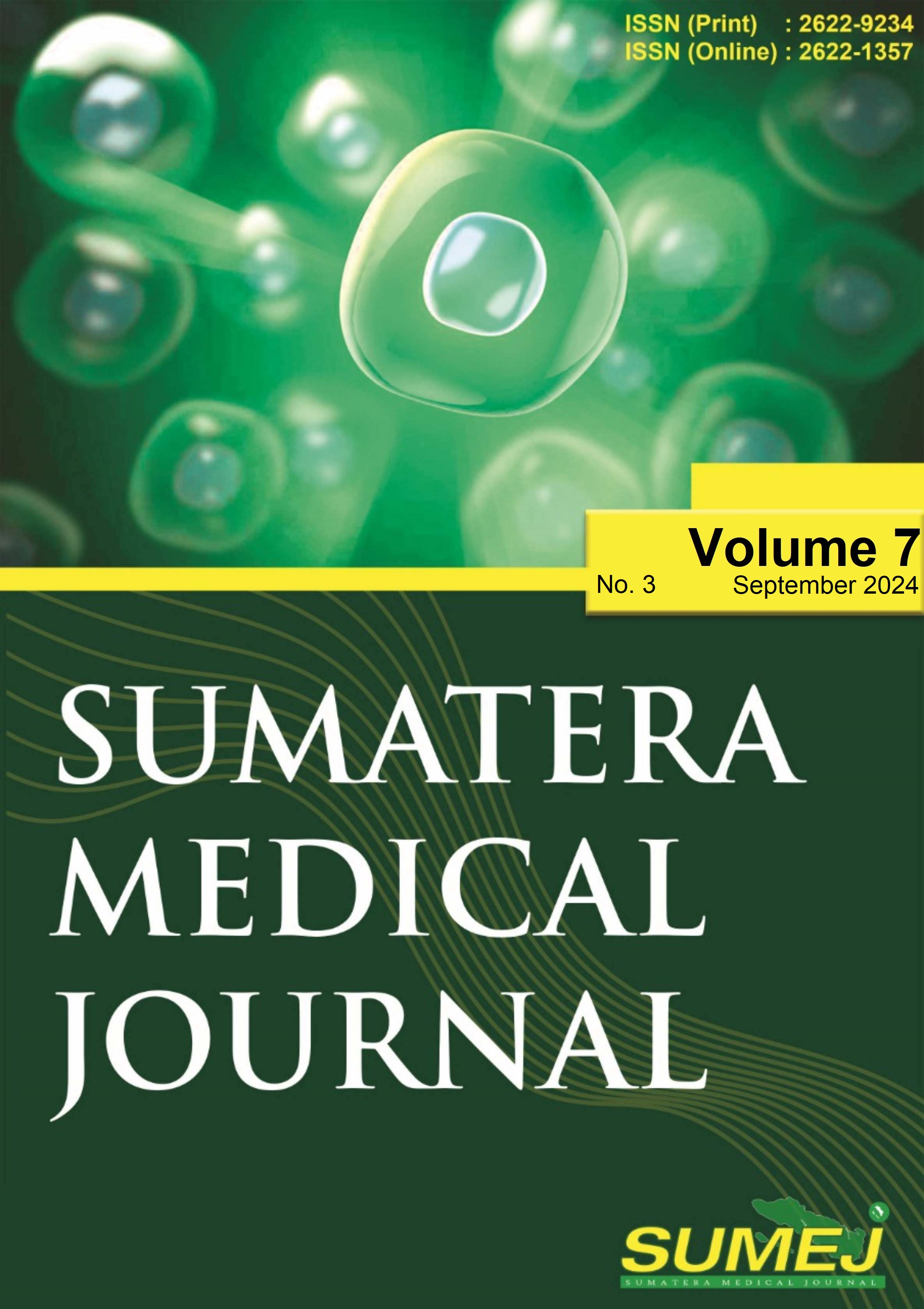Frequency Distribution of Oncology Patients Who Come to Emergency Department at H. Adam Malik Hospital, Medan
DOI:
https://doi.org/10.32734/sumej.v7i3.13698Keywords:
emergency department, multidisciplinary approach, oncologyAbstract
Background: A multidisciplinary approach is needed to comprehensively evaluate cancer patient’s condition and understanding patient demographic characteristics can improve health care by adapting to each patient's needs. Objective: The aim of this study was to explore about frequency distribution of oncolohy patients. Methods: This research is a descriptive observational study with a cross-sectional study design conducted at the Haji Adam Malik General Hospital in Medan on oncology patients who met the inclusion criteria. Data with a numerical measuring scale will be presented in mean+standard deviation (SD) and data with a categorical measuring scale will be presented in frequencies and percentages. Results: The results showed that majority of patients were in 46–59 year age group as much as 32 patients (37.2%) and 58 patients (67.4%) were female. The highest level of education was found in 26 patients (30.2%) as bachelor, and 45 patients (52.3%) lived in Medan City. Most patients came to be treated at the surgical installation as many as 50 patients (25.6%). Conclusion: The research results found that majority of patients are in the age group 46-59 years, female, bachelor, domicile in Medan and are treated in surgical installation.
Downloads
References
Raven MC, Lowe RA, Maselli J, Hsia RY. Comparison of presenting complaint vs discharge diagnosis for identifying ‘nonemergency’ emergency department visits. JAMA. 2013;309(11):1145–53. https://doi.org/10.1001/jama.2013.1948
Trueger NS, Chua KP, Hussain A, Liferidge AT, Pitts SR, Pines JM. Incorporating alternative care site characteristics into estimates of substitutable ED visits. Med Care. 2017;55(7):693–7. https://doi.org/10.1097/MLR.0000000000000733
Scarborough BM, Smith CB. Optimal pain management for patients with cancer in the modern era. CA Cancer J Clin. 2018;68(3):182–96. https://doi.org/10.3322/caac.21453
Temel JS, Greer JA, Muzikansky A, et al. Early palliative care for patients with metastatic non-small-cell lung cancer. N Engl J Med. 2010;363(8):733–42. https://doi.org/10.1056/NEJMoa1000678
Guerriere DN, Zagorski B, Coyte PC. Family caregiver satisfaction with home-based nursing and physician care over the palliative care trajectory: results from a longitudinal survey questionnaire. Palliat Med. 2013;27(7):632–8. https://doi.org/10.1177/0269216312473171
Qureshi D, Tanuseputro P, Perez R, Pond GR, Seow HY. Early initiation of palliative care is associated with reduced late-life acute-hospital use: a population-based retrospective cohort study. Palliat Med. 2019;33(2):150–9. https://doi.org/10.1177/0269216318815794
Brickey J, Flannery M, Cuthel A, et al. Barriers to recruitment into emergency department-initiated palliative care: a sub-study of a multi-site, randomized controlled trial. BMC Palliat Care. 2022;21(1):22. https://doi.org/10.1186/s12904-021-00899-9
Lombardo JS, Burkom H, Pavlin J. ESSENCE II and the framework for evaluating syndromic surveillance systems. MMWR Suppl. 2004;53:159–65.
Heffernan R, Mostashari F, Das D, Karpati A, Kulldorff M, Weiss D. Syndromic surveillance in public health practice, New York City. Emerg Infect Dis. 2004;10(5):858–64.
Mathes RW, Ito K, Matte T. Assessing syndromic surveillance of cardiovascular outcomes from emergency department chief complaint data in New York City. PLoS One. 2011;6(2):e14677.
Shimada N, Ishiki H, Iwase S, et al. Cancer transitional care for terminally ill cancer patients can reduce the number of emergency admissions and emergency department visits. Am J Hosp Palliat Care. 2017;34(9):831–7.
US Cancer Statistics Working Group. US Cancer Statistics: Data Visualizations. Available from: https://www.cdc.gov/cancer/dataviz
Ising A, Proescholdbell S, Harmon KJ, Sachdeva N, Marshall SW, Waller AE. Use of syndromic surveillance data to monitor poisonings and drug overdoses in state and local public health agencies. Inj Prev. 2016;22(Suppl 1):i43–9.
Freund T, Campbell SM, Geissler S, et al. Strategies for reducing potentially avoidable hospitalizations for ambulatory care-sensitive conditions. Ann Fam Med. 2013;11(4):363–70.
Handley NR, Schuchter LM, Bekelman JE. Best practices for reducing unplanned acute care for patients with cancer. J Oncol Pract. 2018;14(5):306–13.
Barbera L, Atzema C, Sutradhar R, et al. Do patient-reported symptoms predict emergency department visits in cancer patients? A population-based analysis. Ann Emerg Med. 2013;61(4):427–37.
National Cancer Institute. Support for People with Cancer: Cancer Pain Control. Bethesda, MD: National Cancer Institute, US Department of Health and Human Services; 2019. NIH publication 19-6287.
Grant M, Ferrell BR, Rivera LM, Lee J. Unscheduled readmissions for uncontrolled symptoms: a health care challenge for nurses. Nurs Clin North Am. 1995;30(4):673–82.
Kurtz ME, Kurtz JC, Given CW, Given BA. Utilization of services among elderly cancer patients—relationship to age, symptoms, physical functioning, comorbidity, and survival status. Ethn Dis. 2005;15(Suppl 2):S17–22.
Noel C, Sutradhar R, Hallet J, Irish JC, Coburn N, Eskander A. Symptom burden as a predictor of emergency room use and unplanned hospitalization in patients with head and neck cancer: a population-based study. J Clin Oncol. 2020;38(15S):12084.
Selassie AW, McCarthy ML, Pickelsimer EE. The influence of insurance, race, and gender on emergency department disposition. Acad Emerg Med. 2003;10(11):1260–70.
Oatley M, Fry M, Mullen L. A cross-sectional study of the clinical characteristics of cancer patients presenting to one tertiary referral emergency department. Int Emerg Nurs. 2016;24:35–8.
Downloads
Published
How to Cite
Issue
Section
License
Copyright (c) 2024 Sumatera Medical Journal

This work is licensed under a Creative Commons Attribution-ShareAlike 4.0 International License.
The Authors submitting a manuscript do so on the understanding that if accepted for publication, copyright of the article shall be assigned to Sumatera Medical Journal (SUMEJ) and Faculty of Medicine as well as TALENTA Publisher Universitas Sumatera Utara as publisher of the journal.
Copyright encompasses exclusive rights to reproduce and deliver the article in all form and media. The reproduction of any part of this journal, its storage in databases and its transmission by any form or media, will be allowed only with a written permission from Sumatera Medical Journal (SUMEJ).
The Copyright Transfer Form can be downloaded here.
The copyright form should be signed originally and sent to the Editorial Office in the form of original mail or scanned document.











